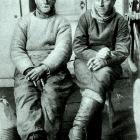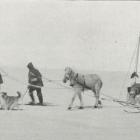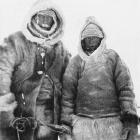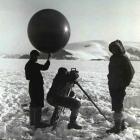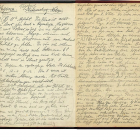NL 001-010_103
Source: Alfred Wegener, Tagebücher, June 1912 – July 1913. DMA NL 001/010.
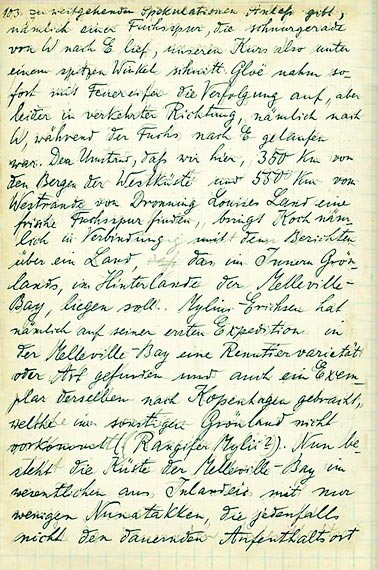
[103] zu weitgehenden Spekulationen Anlaß gibt, nämlich einer Fuchsspur, die schnurgerade von W nach E lief, unseren Kurs also unter einem spitzen Winkel schnitt. Gloë nahm sofort mit Feuereifer die Verfolgung auf, aber leider in verkehrter Richtung, nämlich nach W, während der Fuchs nach E gelaufen war. Der Umstand, daß wir hier, 350 km von den Bergen der Westküste und 530 km vom Westrande von Dronning Louises Land eine frische Fuchsspur finden, bringt Koch nämlich in Verbindung mit den Berichten über ein Land, das im Innern Grönlands, im Hinterlande der Melville-Bay, liegen soll. Mylius-Erichsen hat nämlich auf seiner ersten Expedition in der Melville-Bay eine Rentiervarietät der Art gefunden und auch eine Exemplar derselben nach Kopenhagen gebracht, welche im sonstigen Grönland nicht vorkommt (Rangißer Mylii ). Nun besteht die Küste der Melville-Bay im wesentlichen aus Inlandeis mit nur wenigen Nunatakken, die jedenfalls nicht den dauernden Aufenthaltsort
[103] that has been the object of much speculation—fox tracks, going dead straight from W to E, cutting through our path at an angle. Gloë eagerly took up the chase, but unfortunately, he ran in the wrong direction, namely W, while the fox had gone E. The fact that we found fresh fox tracks here, 350 km from the mountains of the west coast and 530 km from the western edge of Dronning Louise Land, has led Koch to connect this with reports of a place in inner Greenland that is supposedly located in the hinterland of Melville Bay. On his first expedition to Melville Bay, Mylius Erichsen found a variety of reindeer that cannot be found in any other part of Greenland (Rangißer Mylii), and brought it back to Copenhagen with him. Now, the coast of Melville Bay is composed mainly of ice sheet with only a few nunataks, which could not be the permanent habitat




